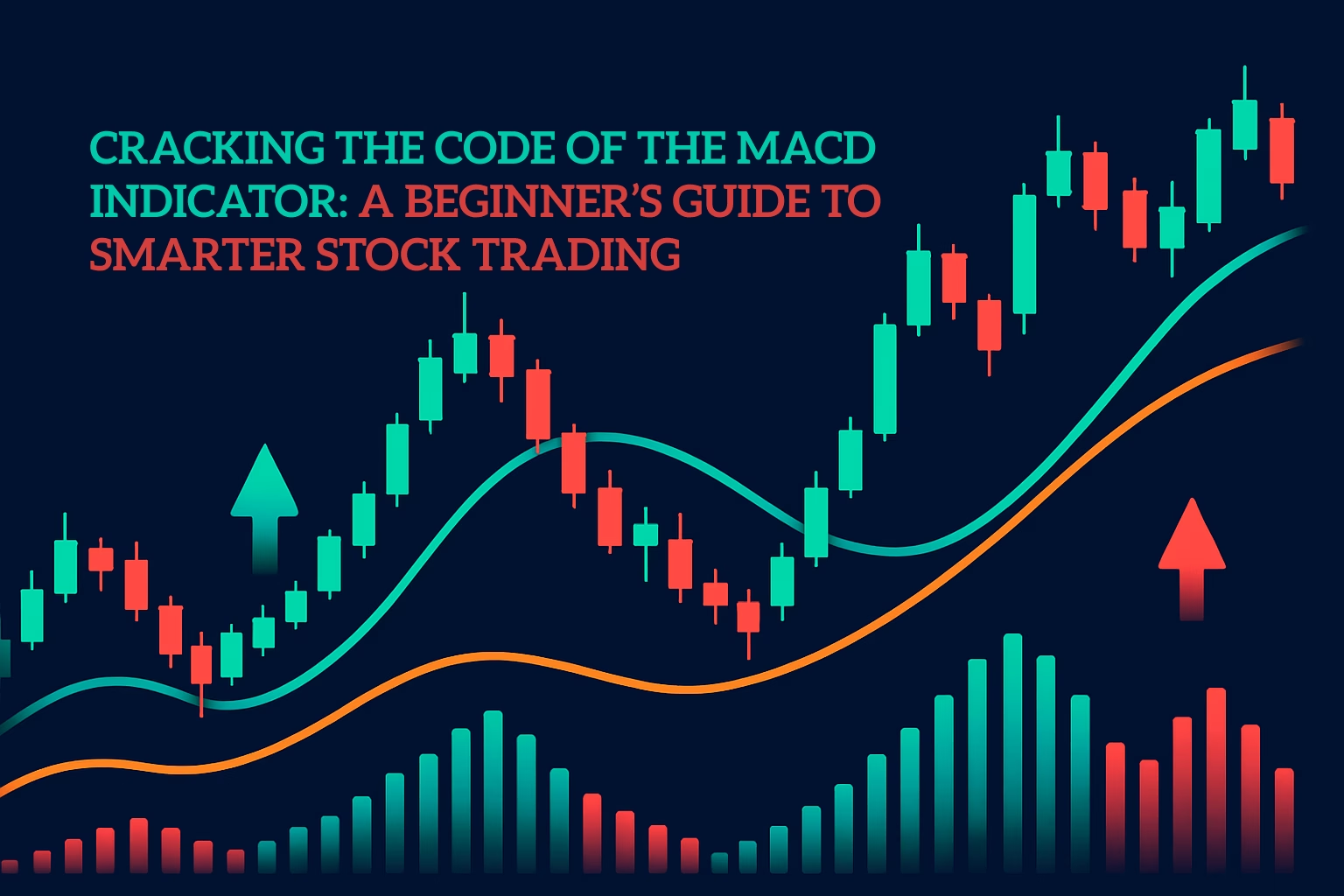Introduction:
In today’s world, growing your money is essential, as its value diminishes daily due to inflation. The stock market is one option that can help you achieve this growth. However, for beginners, navigating the stock market can seem complicated. At the beginning, the learners should focus on the contents explaining the stock market for beginners. Don’t worry! This blog will clarify your initial doubts and provide a clear explanation of how the stock market works.
Table of Contents
What is the Stock Market?
In simple terms, the stock market is a place where people buy and sell shares or stocks of a company. It is an organized platform where investors invest their money in shares of different companies, and the companies raise funds for their business.
When you purchase shares of a company, you become a small owner of that company. When the company’s business grows or makes a profit, the value of your shares also increases and on the contrary, if the company makes a loss, the value of your investment decreases.
For example, Company X has 1 lakh shares. If you buy 100 shares, you will become the owner of 0.1% of the company. When the company’s profit increases, the value of your shares also increases.
How Does the Stock Market Work?
The stock market generally works on the principle of supply and demand. The price of shares fluctuates according to people’s buying and selling activities. Let us understand this process step by step:
1. Listing of The Company:
Shares of companies listed on a stock exchange can only be traded on the stock market. By listing, the company makes its shares available to the public.
When a company sells its shares to the public for the first time, it is called an IPO (Initial Public Offering).
After the IPO, the company’s shares are listed on a stock exchange, such as the NSE (National Stock Exchange) or the BSE (Bombay Stock Exchange). Now, they are available for buy or sell.
2. Interaction between Buyer and Seller:
In the stock market, buyers and sellers interact through an order-driven mechanism. Each transaction is executed only when the buyer and seller’s orders match. This process is automatic and transparent:
(a) Buyer and Seller:
Buyer: The buyer is the person who wants to buy shares. The buyer places a buy order on his broker’s platform (like Zerodha, Groww, Upstox, Robinhood, etc.), where he specifies:
- How many shares to buy (Quantity).
- At what price to buy (Buy Price).
Seller: The seller is the person who wants to sell shares. The seller places a sell order on his broker’s platform, where he specifies:
- How many shares to sell (Quantity).
- At what price to sell (Sell Price).
(b) Role of Brokers in Interaction:
Buyers and sellers cannot place their orders directly on the stock exchange. Here comes the role of brokers. Brokers act as intermediaries who take orders from buyers and sellers on the stock exchange system and handle the settlement and delivery process after the trade is executed.
(c) Order Matching:
The stock exchange system i.e. National Stock Exchange (NSE) or Bombay Stock Exchange (BSE) matches the orders of the buyer and seller. After the match, the trade is executed.
Example:
The buyer places an order to buy 10 shares of X Company at ₹2400 per share. The seller places an order to sell 10 shares of X Company at ₹2400 per share. If the prices of both buyer and seller match, then the trade is executed at that time.
(d) Bid and Ask Price:
The concept of bid and ask price is important if we want to understand the interaction between the buyer and the seller:
Bid Price: The bid price is the price that the buyer is willing to pay.
Ask Price: The ask price is the price that the seller is willing to accept.
Spread: The difference between the bid and ask price.
Example:
The buyer wants to buy shares of Company X at ₹2350 (bid price). The seller wants to sell shares of Company X at ₹2400 (ask price). The spread is (₹2400-₹2350) = ₹50. If the seller lowers his price to ₹2350 or the buyer increases his price to ₹2400, then the trade will be executed.
(e) Market Order and Limit Order:
Buyers and sellers can place their orders in two ways:
Market order: The buyer or seller accepts the best available price.
For the buyer: The shares will be available at the lowest price.
For the seller: The shares will be sold at the highest price.
Limit order: The buyer or seller wants to trade at a specific price.
Example:
Suppose the Current Market Price (CMP) of a share of Company X is ₹2550. If the buyer wants to buy shares of X at ₹2500, he can place a limit order of ₹2500, and the trade will take place only when the price reaches ₹2500.
3. Price Determination:
The price of a share depends on demand and supply in the market:
High demand, low supply: If the number of buyers for a particular share exceeds the number of sellers, i.e. the demand for a share is high but the supply is low, then the price of that share increases.
High supply, low demand: On the other hand, if the number of sellers for a particular share exceeds the number of buyers, i.e. the supply of a share is more but the demand is less, then the price of that share decreases.
Example:
If the demand for X shares increases, then the price can go from ₹2000 to ₹2100. If the demand decreases, the price can come down to ₹1900.
4. Role of Stock Exchanges:
Stock exchanges (like NSE and BSE) provide a clean, safe, and regulated environment for trading. They ensure- (i) Smooth interaction between buyers and sellers. (ii) Fair and secure transactions. (iii) Availability of real-time price information.
5. The Process of Trading:
The trading process is as follows:
Order Placement: Buyer or Seller places an order to buy or sell on the broker’s platform.
Order Matching: After the order is placed, the stock exchange matches the buyer and seller’s orders.
Execution: The transaction is completed once the buyer and seller agree on the price.
Example:
You want to buy 10 shares of Company Y at ₹1500 per share. You first have to place the order on the broker’s platform. When that order reaches the exchange (i.e. NSE or BSE), they will check if any seller wants to sell shares of Company Y at ₹1500. If any seller also wants to sell at ₹1500, then the trade will be executed.
6. Settlement of Trade:
The stock market follows the T+1 settlement cycle. It means:
T(Trade Day): The day the trade is executed.
T+1 (Next Working Day): The day the shares are credited in the demat account of the buyer and the money is transferred to the seller’s account.

Benefits of the Stock Market:
Investing in the stock market is a powerful financial tool that helps to grow money and achieve financial goals. Let’s discuss some of the main benefits of investing in the stock market:
1. Wealth Creation:
Investing in the stock market can be a solid long-term strategy to create wealth. This is because, when a company profits, its share price typically increases over time, generating profits for investors.
2. High Returns:
Investing in the stock market can offer higher returns than other investments, such as fixed deposits or savings accounts. Long-term investors also get the benefit of compounding. Long-term investors generally get 12-15% annual returns, according to historical data.
3. Liquidity (Easy Availability):
The stock market is highly liquid, which means you can buy and sell your shares at any time. If you need money urgently, you can sell your shares and get cash. Moreover, now the concept of pledging has come into play, where instead of selling shares, you can get money by pledging them to get cash instead.
4. Ownership in Companies:
When you buy shares in a company, you become a small co-owner of that company. You get a share of the company’s profits, which come in the form of dividends. If the company performs well and makes a profit, your investment will also grow.
5. Diversification:
The stock market helps you diversify your portfolio. You can invest in different industries, such as technology, healthcare, banking, etc., you can even invest in gold, which reduces risk.
6. Beat Inflation:
Investing in the stock market helps in beating the effects of inflation. Because investing in the stock market gives returns that can beat inflation at some point. The value of money decreases due to inflation, but the income on stocks neutralizes this effect.
Example:
Mr. X started investing in the stock market with ₹5 lakh and invested ₹5,000 every month. After 10 years, his portfolio has grown from ₹11 lakh to ₹30 lakh, while he achieved his goal despite inflation.
Steps to Invest in Stock Market:
Investing in the stock market requires a systematic process. New investors can easily start their investment journey by following the steps below:
1. Set Financial Goals:
Firstly, it is important to understand your investment goals. Do you want short-term gains or long-term wealth creation? What is the investment objective—retirement planning, buying a house, wealth creation, buying a car, or your child’s education? Your investment strategy will depend on your goals.
2. Gain Basic Knowledge:
You need to develop a basic understanding of the stock market. What are shares, mutual funds, Exchange-Traded Funds (ETFs), and derivatives? Understand the relationship between risk and reward, from which you can decide how much risk you are willing to take. Use reliable sources, such as financial websites, books, and various articles available online to improve your knowledge.
3. Opening a Demat Account:
A demat account is required to invest in the stock market. These accounts are opened through brokers, such as: Zerodha, Robinhood, Growth, Upstox, ICICI Direct, or HDFC Securities. Choose a trusted broker that has low or no brokerage charges, no or low Annual Maintenance Charge (AMC), and provides good customer service—required documents: PAN card, Aadhaar card, bank details, and address proof.
4. Do Market Research:
Before buying a stock, you need to do research:
Fundamental analysis: Examine the company’s financials, management, future plans, balance sheet, profit or loss, and growth potential. We do fundamental analysis when we invest for the long term.
Technical analysis: Analyze price charts and trends. Don’t forget to analyze the current state of the market and economy. Technical analysis is useful when trading or investing for the short term.
5. Set a Budget for Investing:
Decide the amount of investment according to your financial capacity. Invest only the money that you can lock in for the long term.
6. Place an Order:
Place your buy or sell order through the broker’s platform:
Market order: The trade is executed at the current price.
Limit order: The trade will be executed at the price at which the buyer or seller wants to buy or sell, respectively.
For example,
If you want to buy 10 shares of Company A at ₹1,500 per share, but its current market price is ₹1,500, you would place a limit buy order, and the order will be executed only when the price drops to ₹1,500.
7. Monitor Portfolio Regularly:
It is important to review your portfolio regularly. This will show whether stocks are still performing as you expected. Are there any changes that need to be made? Avoid over-trading and be patient.
8. Diversification:
Diversify the portfolio across the stocks of different sectors and industries. Don’t concentrate money in one sector which is very risky.
9. Take Long-term View:
Short-term fluctuations are very common in the stock market. Avoid panic selling. Long-term investments are more profitable. If you want to invest regularly, adopt a method like SIP (Systematic Investment Plan).
Conclusion:
Stock market investing is a powerful tool that helps in wealth creation and achieving financial freedom. But success in it requires knowledge, patience, and discipline. If you do the right research and manage your investments thoughtfully, you can achieve your financial goals.



